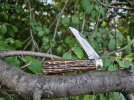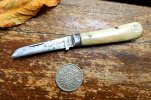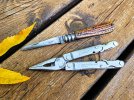Fabulous Rodgers, Wolstenholme and Deakin Bros Trubetzkoy! All in such fantastic unused condition too. Tempting to edge, at least for me

The Wolstenholme is my favourite as is an immediately identifiable form I'm most familiar with. My knowledge of fixed blades and bowies is meagre, can you tell us what you know about them? The stamping on the Rodgers is intriguing, the style would have lead me to believe George V but again I'm not informed. This is relevant to me as I'm facing the same question re a piece I have.
Glad you liked the pic! I'd actually say all three knives were fairly well used by their original owners, as they all have sharpening marks and other signs of wear.
Since you asked, here's a bit more information about each knife, ordered by estimated date of manufacture:
1. The Wostenholm is most likely from the second half of the 19th century, as it's stamped
Washington Works, in reference to their second factory, opened in 1848. Still, the sheath, which I didn't show in my post, but which is made of leather-wrapped cardboard with nickel silver fittings (of which only the original throat survived), suggests that it's a relatively early example. Perhaps 1860-1870 o so. This is consistent with the lack of the word
England or
Engl., which, under the assumption that the knife was exported to the US back in the day, indicates that it's a pre-1890 knife (since as of that date imports had to be marked with the country of origin). More pics, as well as some interesting background on the sheath (for which I created a new chape), have been posted
here and
here.
2. The Deakin was actually not made by Deakin Bros., but by Deakin, Ecroyd & Co. (1868-1874). Though some might refer to it as a bowie, the blade was most likely made for South America, where that shape was commonplace (in what are usually referred to as
gaucho knives), and where Deakin et al. are known to have exported cutlery. However, this particular example seems to have never left the UK until I bought it. More pics have been posted
here and
here, and you can read more about the company
here.
3. Finally, the Rodgers is indeed from George V's period, at least as far as I know, since, as
 Will Power
Will Power
suggested, Rodgers's royal appointment wasn't renewed by George VI, and the celluloid handle indicates that the knife couldn't have been made during George IV's reign (unless it had been a leftover blade from back in the day that wasn't handled and sold until George V's period). As for the type of knife, based on its length (8"), I'd personally call it a slicing knife, or even a brisket knife, though I don't know what these were advertised as back in the day. As a curious side note, such knives, especially when made by Rodgers, are commonly reground and turned into small gaucho knives (referred to as
verijeros) in South America, even today. The bad part is that this practice (which I don't find objectionable per se) is not always disclosed by knifemakers and sellers, so some people buy these knives thinking they're getting an original Rodgers gaucho knife.
Cheers!
Edit: Made some corrections concerning the Deakin knife.
 The Slater presents like a high quality example from new, Ivory being the luxury material even then, its overall condition looks remarkably good and it's in the era too (judging by pattern type, materials and finish) The Harrison does look like an Ettrick to my eye and the pattern certainly can perform many tasks. The etch 'The Docker' is indeed interesting but I suspect it's a piece of whimsy or conceit, the kind of naming you might see on a knife advert or perhaps as some kind of give away knife sent to farmers as a reward or inducement- getting a handy and attractive pocket-knife. The etch also adds to the aesthetics of the knife.
The Slater presents like a high quality example from new, Ivory being the luxury material even then, its overall condition looks remarkably good and it's in the era too (judging by pattern type, materials and finish) The Harrison does look like an Ettrick to my eye and the pattern certainly can perform many tasks. The etch 'The Docker' is indeed interesting but I suspect it's a piece of whimsy or conceit, the kind of naming you might see on a knife advert or perhaps as some kind of give away knife sent to farmers as a reward or inducement- getting a handy and attractive pocket-knife. The etch also adds to the aesthetics of the knife.















